Do you have the boat and are preparing to head out boat cruising? Whether you’ve just stepped off the dock for the first time or have been dreaming of this moment for years, boat cruising opens up a world of adventure, freedom, and the thrill of exploring the open water. While endless horizons and secluded anchorages are undeniably captivating, transitioning from casual or little sailing to cruising requires unique skills and knowledge. We know because we learned the hard way!
This article will guide you through the essential steps to maximize your boat cruising experience. We’ll delve into getting intimately acquainted with your boat, honing your seafaring skills for longer voyages, equipping your cruising boat for extended journeys, planning unforgettable adventures, and embracing the joys and challenges of life on the water. Whether you envision leisurely coastal hops or ambitious offshore passages, these tips will help you chart a course toward confident and rewarding boat cruising experiences.
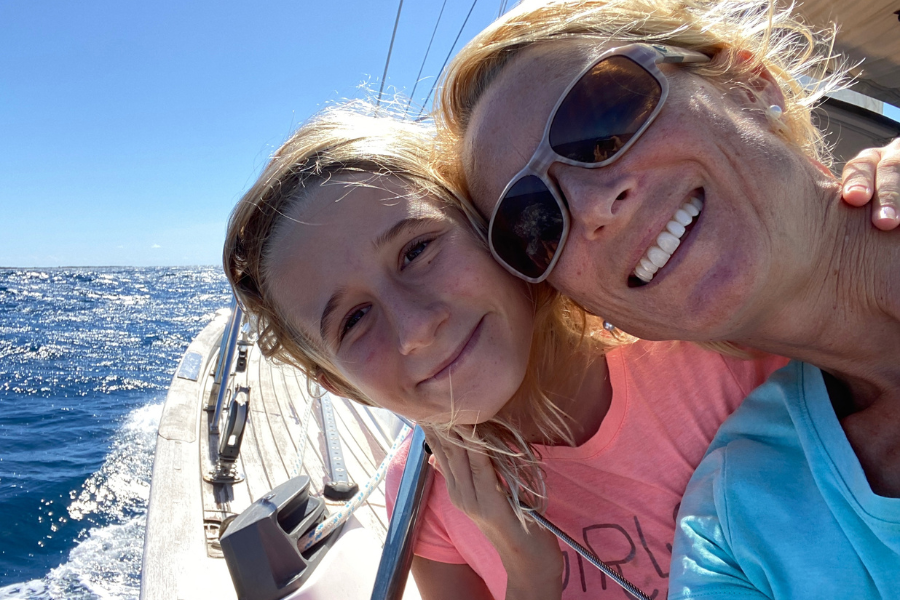
Getting to Know Your Sailing Cruiser
Before you cast off on your maiden boat cruising voyage, it’s crucial to familiarize yourself with every nook and cranny of your new sailing cruiser. The more intimately you understand your boat’s systems, layout, and unique quirks, the more confident and prepared you’ll be when challenges arise during your boat cruising adventures.
- Familiarization:
- Create a Comprehensive Inventory: Document every equipment, tool, and spare part on board. This will help you stay organized and serve as a reference for future maintenance and repairs during your boat cruising trips. Before we crossed the Atlantic Ocean, my husband and daughter had to return to the UK, leaving me in Gran Canaria, waiting for the Atlantic Rally for Cruisers to start. With just me on the boat, I took the time to take everything out and create a massive Excel spreadsheet holding the item, part number, description, and location.
- Systems Deep Dive: Dedicate time to learning the ins and outs of your boat’s electrical system, engine, plumbing, rigging, sails, and navigation instruments. Refer to the owner’s manuals and seek guidance from experienced sailors or professionals to ensure smooth boat cruising. We took a few classes during the lead-up to leaving land with our boat. One of them was a marine Diesel engine course. We also had a professional captain with us for our first long passages. We learned more during those trips than during our entire sailing life!
- Layout and Storage: Explore every compartment and locker, noting the location of safety gear, tools, spare parts, and storage solutions. Knowing where everything is stowed will prove invaluable when underway on your boat cruising adventures. After three years of living on our boat full-time, we found a storage locker for the first time! It held all the electrical items, and we never knew we had it.
- Systems Check:
- Rigging Inspection: Carefully examine all standing and running rigging for wear and tear. Look for frayed lines, loose fittings, and signs of corrosion. For a full rigging inspection checklist, get my guide: Checklists for Sailors. You can also purchase the guide on Amazon.com.
- Sail Evaluation: Assess the condition of your sails, checking for tears, chafe, and UV damage. If repairs are needed, address them before setting sail on your boat cruising adventure.
- Engine Maintenance: Perform a thorough engine check, including oil and filter changes, belt inspection, and coolant levels. If necessary, consult a mechanic for a professional tune-up to ensure a smooth boat cruising experience. Before any long passages, we always completed a full engine service.
- Safety Gear Review: Ensure all safety equipment is in working order and up-to-date. This includes life jackets, flares, fire extinguishers, bilge pumps, and navigation lights, all crucial for safe boat cruising. Make sure to get our FREE Boat Safety Checklist here.
- Cruising Gear Checklist:
- Essential Supplies: Stock up on boat cruising essentials like plotter charts, navigation tools, spare parts, tools, first-aid kits, and extra lines. Check out our list of must-have sailing gear.
- Provisioning: Consider your galley needs for extended boat cruising trips, including non-perishable food, water storage, and cooking fuel.
- Comfort and Convenience: Depending on your preferences, you may want to invest in additional equipment like refrigeration, solar panels, or a watermaker for self-sufficiency during boat cruising.
By thoroughly familiarizing yourself with your sailing cruiser and ensuring all systems are in top shape, you’ll be well-prepared to embark on your boat cruising adventures with confidence and peace of mind.
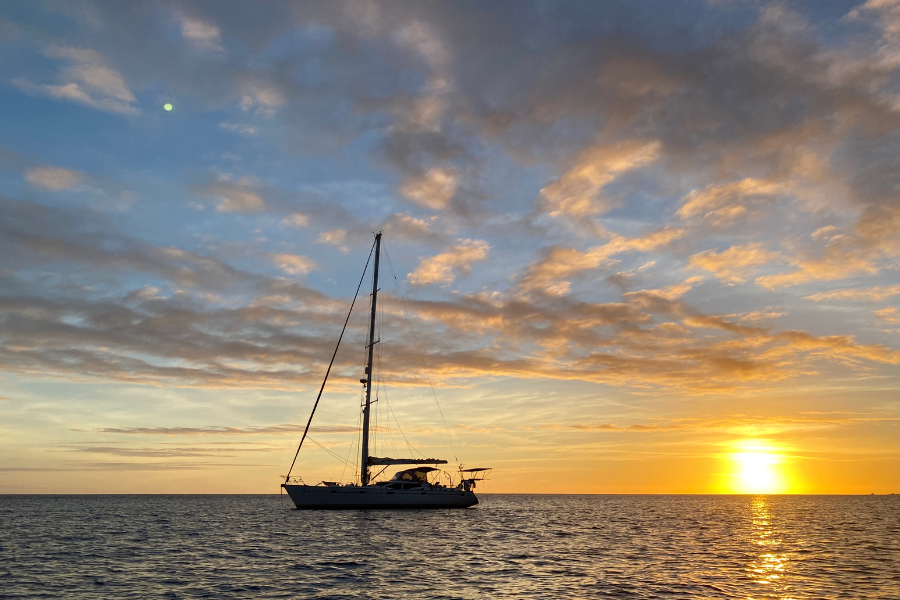
Honing Your Sailing Skills for Boat Cruising
Transitioning from day sailing to boat cruising demands a deeper understanding of seamanship and navigation. While you may be comfortable handling your boat in familiar waters, cruising presents unique challenges that require additional skills and knowledge for a safe and enjoyable experience.
- Refresher Courses or Advanced Training:
- Cruising-Specific Courses: Consider enrolling in courses specifically designed for cruising sailors. These may cover topics like coastal navigation, offshore passage planning, weather interpretation, anchoring in different conditions, and emergency procedures, all essential for boat cruising.
- Skill-Building Workshops: Look for workshops that focus on practical skills such as sail trim, heavy weather sailing, diesel engine maintenance, and troubleshooting onboard systems to enhance your boat cruising capabilities.
- Certification: If you aspire to longer boat cruising passages, consider obtaining certifications like the ASA Offshore Passagemaking course or the RYA Yachtmaster Offshore qualification, which validate your cruising competence. Read my article: ASA Sailing versus RYA Courses – 25 Valuable Things You Need to Know
- Sailing with Experienced Cruisers:
- Crewing Opportunities: Offer to crew on other cruising boats to gain firsthand experience and learn from seasoned sailors. You’ll observe their decision-making processes, gain insights into boat handling techniques, and learn valuable tips for life on board during boat cruising.
- Mentorship: Seek out experienced cruisers who are willing to share their knowledge and expertise. They can offer guidance on everything from boat maintenance to route planning and provide invaluable support as you embark on your boat cruising journey. Check out our Learn To Become A Sailing Cruiser Liveaboard Experiences here!
- Practice, Practice, Practice:
- Diverse Conditions: Take your boat out in a variety of weather conditions to build your confidence and adaptability for boat cruising. Practice sail handling in light winds, moderate breezes, and stronger gusts.
- Maneuvering Mastery: Refine your docking and anchoring skills in different scenarios. Practice maneuvering in tight spaces, under sail, and in varying currents and tides to prepare for boat cruising challenges.
- Navigation Drills: Sharpen your navigation skills by plotting courses, using navigational tools, and practicing dead reckoning.
By actively seeking learning opportunities, sailing with experienced mentors, and dedicating time to practice, you’ll enhance your sailing abilities and become a more confident and competent cruiser. Remember, the journey of learning never ends, and every experience on the water contributes to your growth as a sailor and enriches your boat cruising adventures.
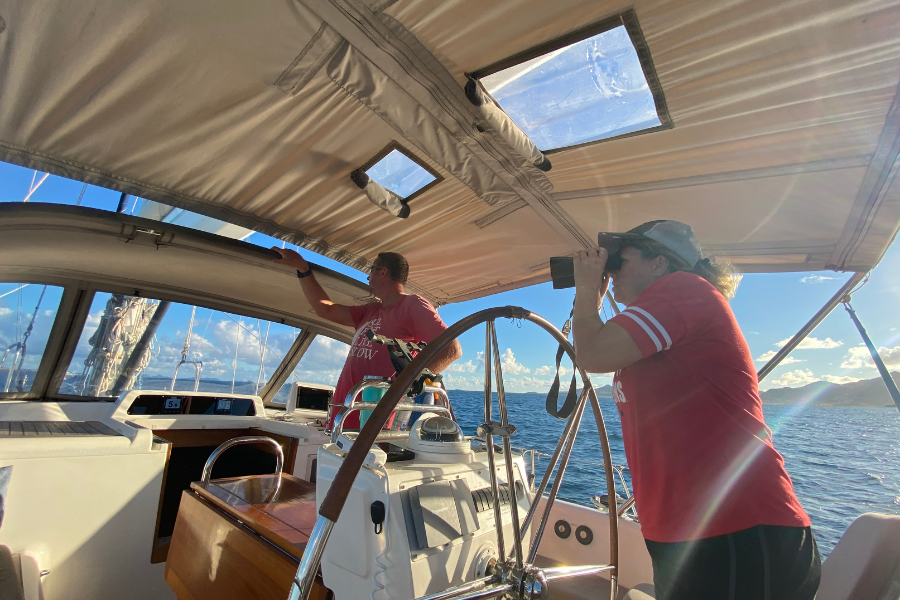
Maintenance and Upgrades for Boat Cruising
Preparing your sailing cruiser for extended voyages and ensuring its longevity on the water requires meticulous maintenance and strategic upgrades. While some upgrades may be specific to your boat cruising goals and personal preferences, others are considered essential for a comfortable and safe experience.
- Cruising-Specific Maintenance:
- Rigging: Regularly inspect your rigging for signs of wear, chafe, or fatigue. Replace worn-out lines, shackles, or turnbuckles promptly. Consider upgrading to stronger or more durable materials if you plan on venturing offshore during your boat cruising adventures.
- Sails: Have your sails professionally inspected and serviced annually. Repair any tears, reinforce high-wear areas, and consider adding UV protection to prolong their lifespan for optimal performance during boat cruising.
- Engine: Implement a strict maintenance schedule for your engine, including regular oil changes, filter replacements, belt inspections, and impeller replacements. If you’re planning extended boat cruising passages, consider carrying spare parts and learning basic engine troubleshooting. Make sure to get my Checklists for Sailors guide, as it has checklists for rigging, engine maintenance, safety checks, and over 50 blueprints for success.
- Hull and Deck: Regularly clean and inspect your hull for blisters, cracks, or other damage. Apply antifouling paint to prevent marine growth. Keep your deck clean and free of debris to avoid slips and falls during boat cruising. We don’t suggest CopperCoat, and this is why: CopperCoat Application Problems
- Essential Upgrades for Boat Cruising:
- Power Generation: If you plan on cruising for extended periods, consider upgrading your power generation capabilities. Installing solar panels, a wind generator, or a fuel-efficient generator will ensure you have ample power for onboard systems, electronics, and appliances, which are essential for comfortable boat cruising.
- Water Management: Invest in a watermaker or additional water storage tanks to extend your cruising range. Consider adding a water filtration system for safe drinking water while boat cruising.
- Refrigeration: A reliable refrigeration system is essential for storing fresh food and keeping perishables cold during longer boat cruising passages.
- Navigation and Communication: Ensure you have up-to-date plotter charts, a reliable GPS system, and a VHF radio with a DSC distress signal for communication and emergencies, which is vital for safe boat cruising. Also, make sure you know how to handle the various types of VHF Marine Radio broadcasts and use the DSC system.
- Safety Equipment: Equip your cruiser with essential safety gear, such as a life raft, EPIRB, flares, a ditch bag with emergency supplies, and a comprehensive first-aid kit, all crucial for boat cruising safety. Make sure to purchase my Boat Safety Checklist guide – that’s a must-have on a boat!
- Comfort and Convenience Upgrades:
- Heating and Cooling: Depending on your boat cruising destinations, consider adding a heating system for colder climates or air conditioning for tropical environments. Check out my article: How To Stay Cool On A Sailboat – 22 Easy Ways
- Entertainment: If you enjoy staying connected or having entertainment options on board, consider adding a satellite TV, a stereo system, or Wi-Fi connectivity to enhance your boat cruising experience.
- Galley Upgrades: Depending on your cooking preferences, you might want to upgrade your galley with a larger stove, an oven, or additional counter space to make boat cruising more comfortable. Make sure to get the Magma nested pots.
Remember, prioritize safety and reliability when selecting upgrades for your boat cruising adventures. Invest in quality equipment that is built to withstand the rigors of the marine environment. By maintaining your cruiser meticulously and choosing upgrades wisely, you’ll enhance your comfort, safety, and enjoyment on the water for years to come during your boat cruising journeys.
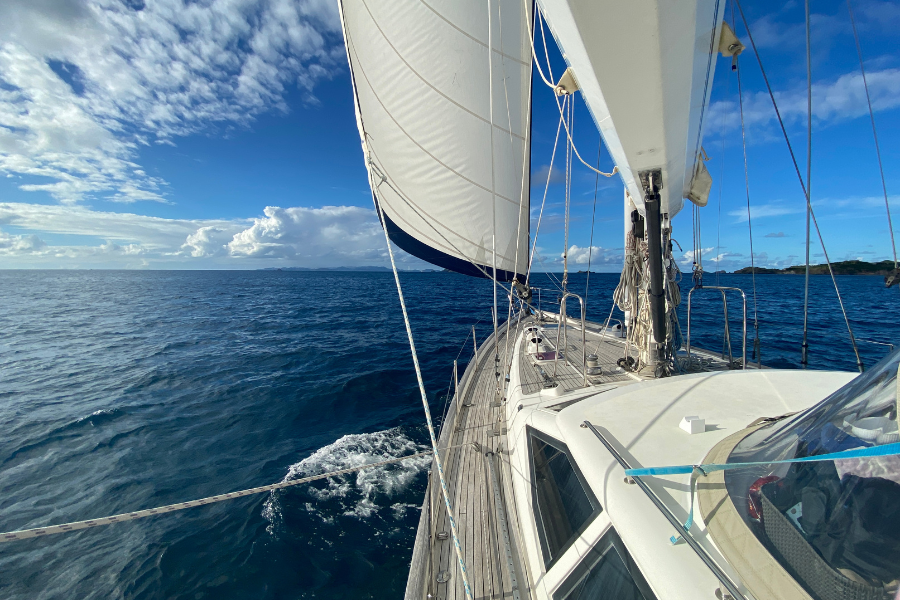
Planning Your Boat Cruising Adventures
With your sailing cruiser prepped and your skills honed, it’s time to chart a course for unforgettable boat cruising adventures. Whether you envision island hopping in the Caribbean, exploring secluded coves along the coast, or embarking on a transoceanic passage, careful planning is key to a safe and enjoyable boat cruising experience.
- Setting Boat Cruising Goals:
- Define Your Cruising Aspirations: Consider the type of boat cruising that appeals to you most. Do you prefer short weekend getaways, extended coastal explorations, or ambitious bluewater passages? Defining your goals will help you choose destinations and plan itineraries accordingly.
- Research Destinations: Gather information on potential boat cruising grounds, including weather patterns, navigation hazards, anchorages, marinas, and local regulations. Consult cruising guides, charts, and online resources to get a comprehensive overview.
- Create Itineraries: Develop detailed itineraries for your planned boat cruising trips, outlining distances, estimated travel times, potential stops, and alternative plans in case of unexpected weather or delays.
- Safety First:
- Safety Equipment: Ensure your cruiser is equipped with all mandatory safety gear, such as life jackets, flares, fire extinguishers, and a VHF radio. Consider additional safety equipment like an EPIRB (Emergency Position Indicating Radio Beacon), a life raft, and a ditch bag with essential survival supplies for your boat cruising adventures.
- Safety Plan: Create a comprehensive safety plan that outlines emergency procedures like man overboard, fire, grounding, or medical situations. Practice these procedures regularly with your crew to ensure safety during boat cruising.
- Weather Monitoring: Stay informed about weather conditions before and during your voyages. Monitor forecasts, be aware of potential storms or hazards, and adjust your plans accordingly for safe and enjoyable boat cruising.
- Weather Routing for Boat Cruising:
- Learn to Interpret Forecasts: Understand weather patterns and how they affect sailing conditions. Learn to read weather charts, satellite imagery, and GRIB files to make informed decisions during boat cruising.
- Utilize Weather Routing Tools: Consider using online weather routing services or software to help you plan routes that minimize exposure to adverse weather conditions, ensuring a safe and enjoyable boat cruising experience. We use PredictWind – it’s the best.
- Adapt to Changing Conditions: Be prepared to alter your course or seek shelter if weather conditions deteriorate unexpectedly while boat cruising.
- Provisioning and Galley Management for Boat Cruising:
- Meal Planning: Plan your meals for the duration of your boat cruising trip, taking into account dietary restrictions and preferences.
- Stocking Up: Stock your galley with non-perishable food items, canned goods, dried fruits and vegetables, grains, and snacks. Purchase fresh produce and perishables closer to your departure date for your boat cruising adventure.
- Storage and Organization: Optimize storage space in your galley, utilizing bins, containers, and hanging organizers. Properly store food to prevent spoilage and maintain a clean and organized space during your boat cruising trip.
- Waste Management: Develop a plan for managing waste on board, including trash disposal and recycling for responsible boat cruising.
By setting clear goals, prioritizing safety, understanding weather patterns, and planning your provisions carefully, you’ll be well-prepared to embark on exciting boat cruising adventures that are both safe and enjoyable.
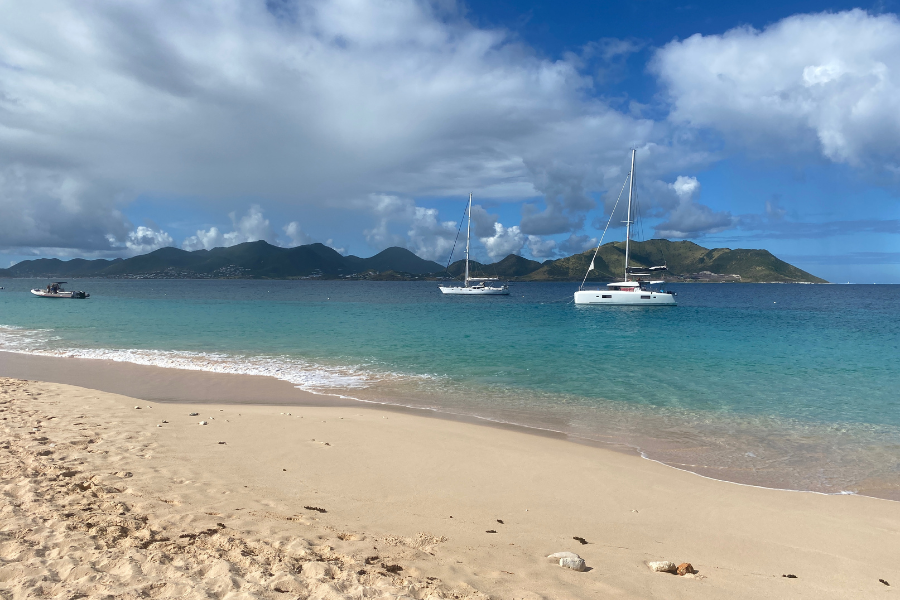
Embracing the Boat Cruising Lifestyle
Beyond the practicalities of boat preparation and navigation, boat cruising is a lifestyle that offers unique rewards and challenges. As you embark on your voyages, you’ll discover a world of camaraderie, self-sufficiency, and a deeper connection with nature.
- Finding Your Boat Cruising Community:
- Online Forums and Social Media: Connect with fellow boat cruisers through online forums, Facebook groups, and social media platforms dedicated to sailing and cruising. Share experiences, ask questions, and find valuable resources.
- Cruising Clubs and Associations: Consider joining cruising clubs or associations, such as the Seven Seas Cruising Association or the Ocean Cruising Club. These organizations offer a wealth of resources, support, and opportunities to connect with other cruisers.
- Marinas and Anchorages: Strike up conversations with fellow boat cruisers in marinas and anchorages. You’ll find a welcoming community of like-minded sailors who are eager to share stories and tips.
- Adapting to Life Afloat:
- Living in a Smaller Space: Embrace the simplicity of life on board during your boat cruising adventures. Learn to declutter, organize efficiently, and prioritize essentials.
- Conserving Resources: Practice water conservation, utilize solar power or wind energy, and minimize waste to reduce your environmental impact while boat cruising.
- Self-Sufficiency: Learn basic skills like engine maintenance, sail repair, and cooking on board. Develop a sense of self-reliance and resourcefulness for a fulfilling boat cruising experience.
- Environmental Stewardship:
- Minimize Waste: Practice responsible waste disposal by reducing, reusing, and recycling whenever possible during your boat cruising trips. Avoid single-use plastics and opt for eco-friendly products.
- Protect Marine Life: Be mindful of marine ecosystems and avoid anchoring in sensitive areas. Follow responsible fishing practices and adhere to local regulations while boat cruising.
- Leave No Trace: Leave each anchorage or destination as pristine as you found it. Pick up any trash you encounter and minimize your impact on the environment during your boat cruising adventures.
- Enjoying the Boat Cruising Journey:
- Embrace Slow Travel: Savor the journey rather than rushing from one destination to the next during your boat cruising adventures. Allow yourself time to explore, relax, and connect with nature.
- Connect with Local Cultures: Immerse yourself in the local culture of the places you visit during your boat cruising trips. Sample local cuisine, attend festivals, and interact with residents to gain a deeper understanding of their way of life.
- Document Your Adventures: Keep a logbook or journal to record your boat cruising experiences, observations, and reflections. Capture memories through photographs and videos to share with friends and family.
By embracing the boat cruising lifestyle, you’ll discover a world of personal growth, adventure, and fulfillment. It’s a chance to disconnect from the hustle and bustle of everyday life and reconnect with the natural world. So, cast off your lines, set your sails, and let your boat cruising adventure begin!
As you embark on your boat cruising journey, remember that owning a sailing cruiser is not just about the destination; it’s about embracing the entire experience. It’s about the thrill of navigating new waters, the tranquility of anchoring in secluded bays, the camaraderie of fellow sailors, and the personal growth that comes with stepping outside your comfort zone.
By following the tips and advice outlined in this open boat cruising guide, you’ll be well-equipped to navigate the challenges and reap the rewards of the cruising lifestyle. From getting to know your boat intimately to honing your sailing skills, preparing for extended voyages, planning exciting adventures, and embracing the unique culture of life afloat, each step will bring you closer to fulfilling your boat cruising dreams.
So, hoist your sails, feel the wind in your hair, and let the adventure unfold. May your boat cruising journeys be filled with fair winds, breathtaking sunsets, and unforgettable moments that will forever enrich your life. Happy sail boat cruising!
A Day In The Life of a Sailing Cruiser
Enjoyed reading your guide on boat cruising! Your insights are really helpful, especially for first-timers like me. Quick question: While planning routes, should we focus more on weather conditions or on landmarks and destinations? Trying to get a sense of what’s more crucial for safety and enjoyment. Thanks for sharing your experiences!”
Hey Lidia – when planning routes safety is most important, so things like weather conditions must be a priority. I’d say that over 50% of the time we diverted to different destinations due to to weather/sea state. It’s best to have a loose plan and go where the wind wants to take you. Enjoy your journey! Kim